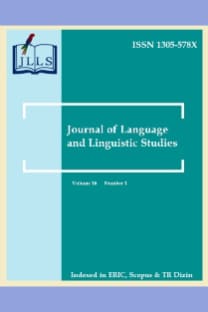Dil değişimi: Pakistan reklamlarında kod karıştırma ve kod değiştirme
Language variation: Code-mixing and code-switching in Pakistani commercials
___
- Akinyi, A. J. (2017).The patterns of language-mixing in print adverts of commercial banks and mobile telecommunications firms in Kenya. International Journal of Education and Research, 5(5), 27-40.
- Awan, S., & Sheeraz, M. (2011). Gender-oriented code-switching: a study of English language teachers at Pakistani universities. International Journal of Academic Research, 3(4), 410-415.
- Crystal, D. (1985). The Cambridge encyclopedia of language. Cambridge University Press: NewYork.
- Dimova, S. (2012). English in Macedonian television commercials. World Englishes, 31(1), 15–29.
- Ehsan, A., & Aziz, S. A. (2014). Code-mixing in Urdu news of a private Pakistani channel.Academic Research International, 5(1), 160-169.
- Elena S., & Gritsenko, E. S. (2016). English as a meaning-making resource in Russian-based professional communication. Procedia - Social and Behavioral Sciences, 236, 174 – 180. DOI:10.1016/j.sbspro.2016.12.061
- Horasan, S. (2014). Code-switching in EFL classrooms and the perceptions of the students and teachers. Journal of Language and Linguistic Studies, 10(1), 31-45.
- Hsu, J. L. (2013). English mixing in advertising in Taiwan: A study of English-literate readers’ attitudes .Concentric: Studies in Linguistics, 39(1), 91-122.
- Humaira. (2012). Code switching and code mixing in English classroom. Retrieved from:http://humairahbima.blogspot.com/2012/05/code-switching-and-code-mixingin.html
- Kachru. (1986. 8 April 2012 ). Code-mixing, style repertoire and language variation: English in Hindu Poetic creativity. World Englishes. Retrieved from: http://www.edu.utas.edu.au/users/tle/ JOURNAL /issues/2008/24-2pdf
- Kandace, E. (2004). Mixed messages: English in German advertising. Journal of language for international business, 15(1), 41-61.
- Kia, L.S. (2011). Code-mixing of English in the entertainment news of Chienese newspapers in Malaysia. International Journal of English Linguistics, 1(1), 3-14.
- Khan, A. M. (2014). Social aspects of code-switching: An analysis of Pakistani television advertisements. Information Management and Business Review, 6(6), 269-279.
- Lopes, E. I. (2002). English/Spanish code switching in Chicano short fiction. Retrieved on August 12, 2018 from: http://urn.fi/URN:NBN:fi:jyu-2002894967
- Mushtaq, H., & Zahra, T. (2012). An analysis of code-mixing in Pakistani commercials.Language in India, 12, 428-439.
- Nandi, S. (2013). The status of English in Indian advertisement. International Journal of Electronics & Communication Technology, 4 (1), 148-151.
- Noor, M., Mustafa, R., Muhabat, F., & Kazemian, B. (2015). The language of TV commercials’ slogans: a semantic analysis. Communication and Linguistics Studies, 1(1), 7-12.
- Rasul, S. (2006). Language hybridization in Pakistan as socio-cultural phenomenon: An analysis of Code-mixed linguistic patterns. Retrieved from http://prr.hec.gov.pk/thesis/2426.pdf
- Rasul, S. (2013). Borrowing and code mixing in Pakistani children’s magazines: practices and functions. Pakistaniaat: A Journal of Pakistan Studies, 5(2), 46-72.
- Riaz, M. & Khan, M. K. (2013). Functions of Codemixing: the adaptation of borrowed words for creating humour in Urdu poetry. Pakistan Journal of Languages and Translation Studies, 2, 45-57.
- Senaratne, C. D. (2017). Creativity in the use of Sinhala and English in advertisements in Sri Lanka: A morphological analysis. International Journal of Cognitive and Language Sciences, 11(1), 7-12.
- Shinhee, L. J. (2006). Linguistic constructions of modernity: English mixing in Korean television commercials. Language in Society, 35, 59-91.
- Shooshtari, Z. G., & Allahbakhsh, M. (2013). Mixing English in Persian print advertising discourse. International Journal of Society, Culture & Language, 1(2), 82-103.
- Skiba, R. (1997). Code switching as a countenance of language interference, The Internet TESL Journal, 3(10).
- Tina, A. A. (2015). Bengali - English code - switching in commercial signboards in Bangladesh. Retrieved on July 7, 2018 from: http://hdl.handle.net/20.500.11948/1161
- Vizcaíno, M. J. G. (2011). Humour in code-mixed airline advertising. Pragmatics, 21(1), 145-170.
- Yuliana, N., Luziana, A. R., & Sarwendah, P. (2017). Code-mixing and code-switching of Indonesian celebrities: a comparative study. Jurnal Lingua Cultura, 9 (1), 47-54.
- Zhiganova, A. V. (2016). The study of the perception of code-switching to English in German advertising. Procedia - Social and Behavioral Sciences, 236, 225 – 229. DOI:10.1016/j.sbspro.2016.12.011
- ISSN: 1305-578X
- Yayın Aralığı: 4
- Başlangıç: 2005
- Yayıncı: http://www.jlls.org
Avrupa dil portfolyosu üniversite seviyesinde İngilizce öğrenmeyi teşvik ediyor mu?
İsmail Hakkı MİRİCİ, Burcu ŞENTÜRK
Anlatma becerilerinde bir iletişim aracı olarak kullanılan emoticon tekniğinin incelenmesi
Fonetik transkripsiyonun İran EFL öğrencilerinin kelime vurgusu öğrenmelerine etkisi
Dinçay KÖKSAL, Ömer Gökhan ULUM
Yayınlanmış araştırma makalelerinde sözcük öbeklerinin yapısal ve işlevsel analizi
Nurullah ŞAHİN, Faruk POLATCAN
İngilizce derslerinde dil alaşımı: Öğretmenlerin tutumları ve uygulamaları
